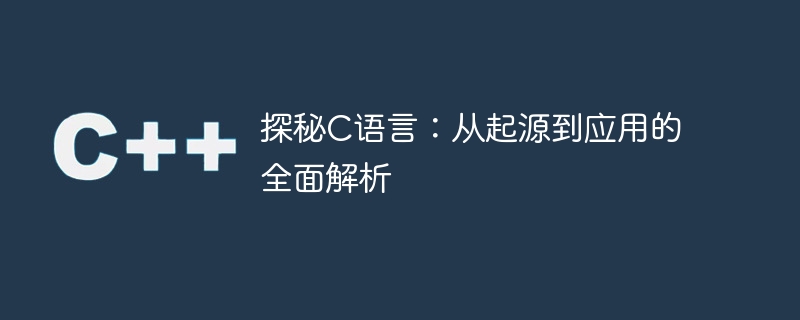

Exploring the C language: a comprehensive analysis from origin to application
1. Introduction
C language is a high-level programming language widely used in computer programming. Developed in 1972 by Dennis Ritchie. Since its birth, C language has been one of the most important languages in the field of programming and is widely used in many fields such as system development, embedded devices, network programming, and game development. This article will comprehensively analyze the C language and explore its secrets from its origin to its application.
2. Origin and Development
The origin of C language can be traced back to the early 1970s, when the computer industry was developing rapidly. Dennis Ritchie and Ken Thompson developed a programming language called "Language B" at Bell Labs, which was the predecessor of the C language. Later, in order to develop the UNIX operating system, Ritchie and Thompson improved the B language, and the C language was born.
The emergence of C language has attracted widespread attention and use. It is precisely because of the simplicity, efficiency and portability of C language that it has become the preferred programming language for various computer systems and platforms. At the same time, C language is also the basis for other high-level programming languages, such as C, Objective-C, etc.
3. Features and Syntax
C language has many commendable features. First of all, C language has strong expressive ability and flexibility. It provides rich syntax structures and operators, allowing programmers to flexibly perform arithmetic, logic, assignment and other operations. Secondly, C language code compiles very quickly and can generate efficient machine code. In addition, C language also supports direct access to hardware resources, making it important in the field of embedded device and system programming.
The syntax of C language is relatively simple and to the point. It mainly consists of expressions, statements and functions. Expression is the most basic unit in C language, which consists of operands and operators. Statements are blocks of code that perform specific operations, such as assignments, conditionals, and loops. Functions are an important part of the C language. They can encapsulate a piece of independent code logic and be called repeatedly. In addition, C language also has rich data types, such as integer, floating point, character and pointer types.
4. Application of C Language
Due to the high efficiency and portability of C language, as well as extensive hardware and operating system support, it is widely used in various fields. Below we introduce several typical application areas.
5. Summary
As a programming language, C language has a profound history and wide applications. Its simplicity, efficiency and portability make it play an important role in the field of computer programming. This article provides a comprehensive analysis of the origin, characteristics and applications of C language. With the continuous development of computer technology, I believe that C language will continue to play an important role in the future, bringing more creativity and challenges to programmers.
The above is the detailed content of Revealing the secrets of C language: an in-depth analysis of its origins and applications. For more information, please follow other related articles on the PHP Chinese website!




